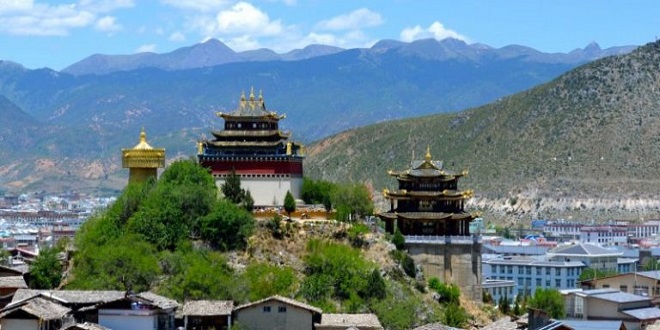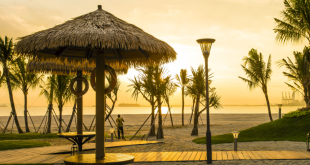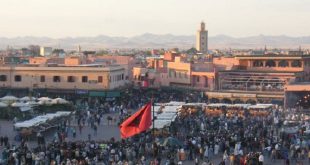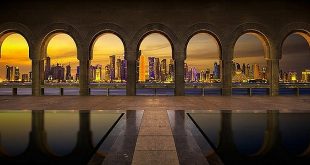We travelled into Tibet from China via the highest railway in the world, it reaches over 5000m above sea level at its highest point and the carriages are specially designed to include UV protection and provide oxygen for passengers.
The train line terminates in the Capital city Lhasa. We spent 3 days there, visiting the Potala Palace, where the Dalai Lama lived, (now a museum) and other monasteries as well as acclimatising to the altitude – we had mild altitude sickness (which felt like a hangover) and found that we were out of breath after climbing just a couple of flights of stairs (what it must feel like to be really unfit!).
Namtso Lake with the Holy Rocks
On our fourth day we went to Namtso Lake, which according to the sign next to it is “The highest lake in the world” – it isn’t. It isn’t even the highest lake in Tibet! Although it is the highest saltwater lake in the world, so there is a legitimate claim to fame. Namtso lake was beautiful (and mostly frozen), as were the surrounding holy rocks, including one shaped like hands in prayer position.
We then started the drive from Lhasa towards the Nepal border, stopping briefly at Yamdrok lake, which was incredibly stunning, (maybe added to by the fact that at this altitude there is less oxygen, but) it literally took my breath away – the perfect turquoise water reflecting the surrounding mountains. I could have stayed there all day looking at it, but unfortunately we only had half an hour before we had to continue.
Another highlight for us was Everest (pretty obvious really!). We got to stay at base camp (5200m above sea level), where it was about -10 Celsius (we think) at night! Certainly the coldest I’ve ever camped in – the ‘hotels’ at base camp are tents (there is also a post office tent and an Internet cafe tent!). We managed to survive (and even get a bit of sleep) thanks to the yak wool blankets…on top of our sleeping bags…with our sleeping bag liners….and our 3 or 4 layers of clothes inside. I woke up needing the toilet and had to go, and the toilets were outside! It was so cold, but it was a cloudless night and I saw more stars than I’d ever seen before, it was pretty awesome.
The wheels behind Potala Palace
Tibet offered some of the best, worst and strangest public toilet experiences I’ve ever had – the best, at about 5500m at a mountain pass on the way to Everest, not particularly clean or anything, but what a view. The majestic beauty of the mountains is ideal whilst you do your business! The worst, I won’t go into details, but squat toilets with no privacy or what seems like any attempt to clean (or empty) them ever is all you need to know.
In terms of the strangest, it was a toilet in a little village where we had stopped for lunch and I can honestly say it was the first time that I’ve ever nearly pooed on a cow’s head! Another squat toilet (as usual) with a 1 m drop or so and as I was squatting I heard a rustle below and then a cow appeared below me, looking for food (quite disgustingly), and wouldn’t go away for some time (despite my shoo-ing) and I had to hold it – quite strange indeed.
There are some magnificent landscapes in Tibet, from the snow topped Himalayas to the odd sand dessert, and some vast barren moon-like landscapes.
Making a ‘Kora’ in Lhasa
Tibet is amazing, we really enjoyed it, but also felt so angry and saddened for the Tibetan people as well. Our guide was Tibetan and very open about how he felt and how the situation is. He was taking a big risk, if we were overheard by the police, he would’ve been locked up for what he told us. Last year 100’s of monks were arrested for demonstrating for Tibetan independence and no-one knows where they are, or even if they are still alive. Our guide saw about 100 Tibetan people killed in front of his eyes in the demonstrations last year, and during April this year (the 50th anniversary of the Dalai Lama leaving Tibet in exile, when Tibet was closed by the Chinese Government), people were not allowed out at night or would risk getting shot, and the military presence was ramped up considerably. Having a picture of the Dalai Lama or a Tibetan flag is an arrestable (or quite possibly worse) offence, and it is almost impossible for Tibetans, unless they are rich enough, to get a passport and leave the country legitimately.
In the capital Lhasa only about 5% of businesses are Tibetan owned, and the army are given police uniforms or in monasteries wear armbands saying ‘fire inspector’ and other laughable titles to fool tourists.
The Chinese government employs around 30,000 people to censor websites – if you employ that many people, you’ve got something to hide! Also, to use an internet cafe in China you have to show your passport or ID. In Tibet, our guide was telling us, if someone looks at certain web pages (anything related to Tibetan independence etc) the army will soon arrive to arrest them. There are also phone taps on all phones in Tibet, email monitoring and hidden microphones and cameras around the tourist hot spots like the Potala Palace.
Yamdrok Lake sparkles with colour
All schools in Lhasa now teach in Mandarin Chinese rather than Tibetan. The culture of the Tibetan people is being systematically eroded and tensions are increasing between natives and the large influx of Han Chinese now living in Tibet. I recently read the Pianist (the true story of a Jewish guy in Warsaw who survived the holocaust), and what the Chinese government appear to be doing in Tibet shares more than a few parallels with the Nazi government in Warsaw.
Yet despite all this the Tibetan people (appear to) manage to stay sane, some even optimistic, our guide and driver and just about every other Tibetan we met was really friendly.
We found ourselves at a real loss as to what can be done about Tibet and what we can do – not much I suppose. From the stories our guide told us it was easy to feel resentment toward the Chinese people, but as always it’s the government, not the people who are responsible.
Conclusion
Being in Tibet felt strange, we felt extremely privileged to see the country, the stunningly beautiful landscapes and the incredible culture, but the permit price, most of the price for the (mandatory) guide and entrance to monasteries etc goes to the Chinese Government, which is then probably used to further suppress Tibet. Yet the Dalai Lama’s advice for foreigners is to visit Tibet, see the situation for themselves, and tell others!
 TRUTHREVIEWERS
TRUTHREVIEWERS




